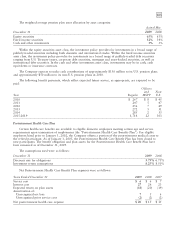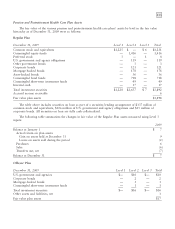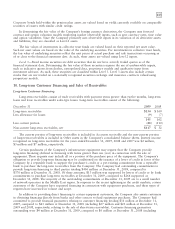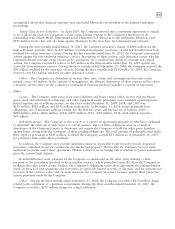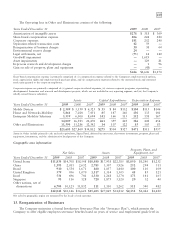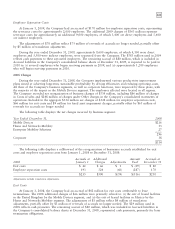Motorola 2009 Annual Report Download - page 119
Download and view the complete annual report
Please find page 119 of the 2009 Motorola annual report below. You can navigate through the pages in the report by either clicking on the pages listed below, or by using the keyword search tool below to find specific information within the annual report.
111
At December 31, 2009, the Company had unrecognized compensation expense related to RSUs of
$269 million, net of estimated forfeitures, expected to be recognized over the weighted average period of
approximately three years. The total fair value of RS and RSU shares vested during the years ended December 31,
2009, 2008 and 2007 was $44 million, $19 million and $13 million, respectively. The aggregate fair value of
outstanding RSUs as of December 31, 2009 was $438 million.
Total Share-Based Compensation Expense
Compensation expense for the Company’s employee stock options, stock appreciation rights, employee stock
purchase plans, RS and RSUs was as follows:
Year Ended December 31 2009 2008 2007
Share-based compensation expense included in:
Costs of sales $32$32$33
Selling, general and administrative expenses 170 155 188
Research and development expenditures 94 93 94
Share-based compensation expense included in Operating earnings (loss) 296 280 315
Tax benefit 95 86 99
Share-based compensation expense, net of tax $ 201 $ 194 $ 216
Increase in basic loss per share $(0.09) $(0.09) $(0.09)
Increase in diluted loss per share $(0.09) $(0.09) $(0.09)
Motorola Incentive Plan
The Motorola Incentive Plan provides eligible employees with an annual payment, calculated as a percentage
of an employee’s eligible earnings, in the year after the close of the current calendar year if specified business
goals and individual performance targets are met. The provisions for awards under these incentive plans for the
years ended December 31, 2009, 2008 and 2007 were $190 million, $172 million and $190 million, respectively.
Long-Range Incentive Plan
The Long-Range Incentive Plan (‘‘LRIP’’) rewards participating elected officers for the Company’s
achievement of specified business goals during the period, based on two performance objectives measured over
three-year cycles. The provision for LRIP (net of the reversals of previously recognized reserves) for the years
ended December 31, 2009, 2008 and 2007 was $9 million, $(13) million and $(8) million, respectively.
9. Fair Value Measurements
The Company adopted new accounting guidance on measuring fair value on January 1, 2008 for all financial
assets and liabilities and non-financial assets and liabilities that are recognized or disclosed at fair value in the
financial statements on a recurring basis. This does not change the accounting for those instruments that were,
under previous U.S. GAAP, accounted for at cost or contract value. The Company has no non-financial assets and
liabilities that are required to be measured at fair value on a recurring basis as of December 31, 2009.
The Company holds certain fixed income securities, equity securities and derivatives, which must be
measured using the authoritative accounting guidance for fair value hierarchy and related valuation
methodologies. The guidance specifies a hierarchy of valuation techniques based on whether the inputs to each
measurement are observable or unobservable. Observable inputs reflect market data obtained from independent
sources, while unobservable inputs reflect the Company’s assumptions about current market conditions. The
prescribed fair value hierarchy and related valuation methodologies are as follows:
Level 1—Quoted prices for identical instruments in active markets.
Level 2—Quoted prices for similar instruments in active markets, quoted prices for identical or similar
instruments in markets that are not active and model-derived valuations, in which all significant inputs are
observable in active markets.
Level 3—Valuations derived from valuation techniques, in which one or more significant inputs are
unobservable.






